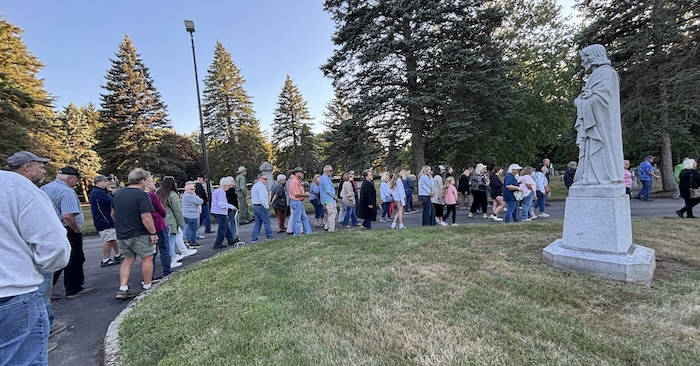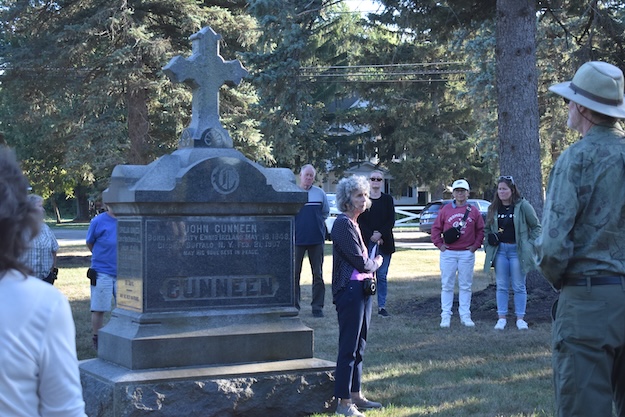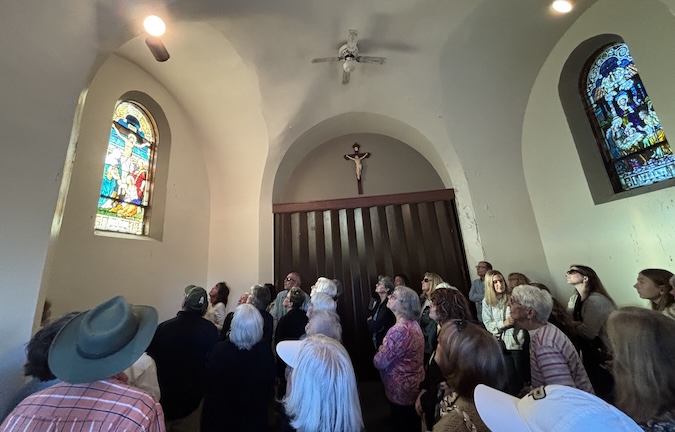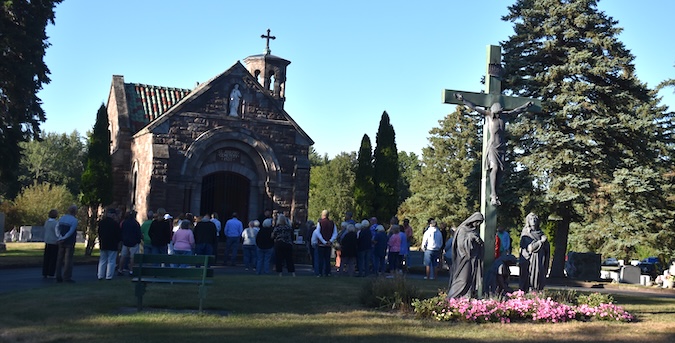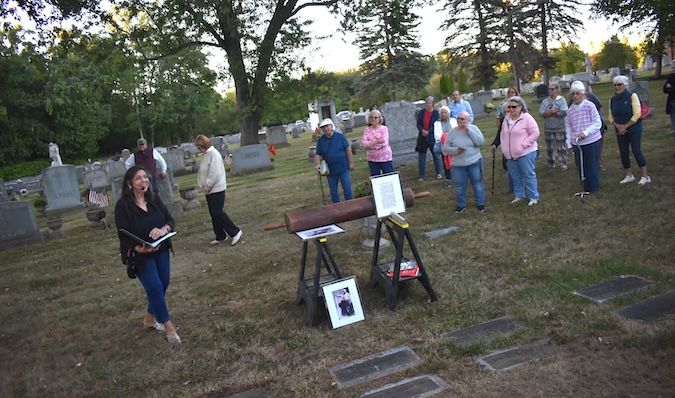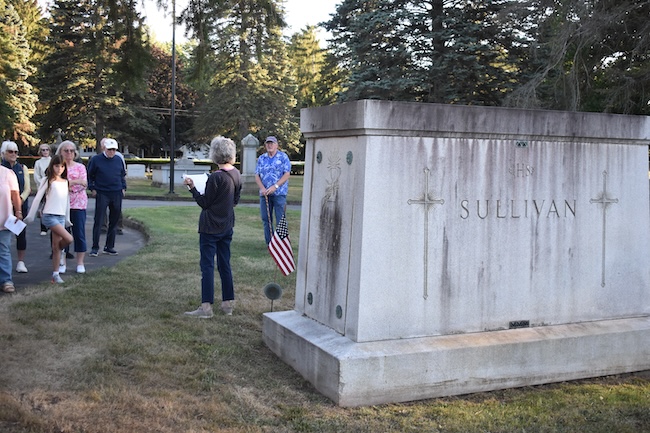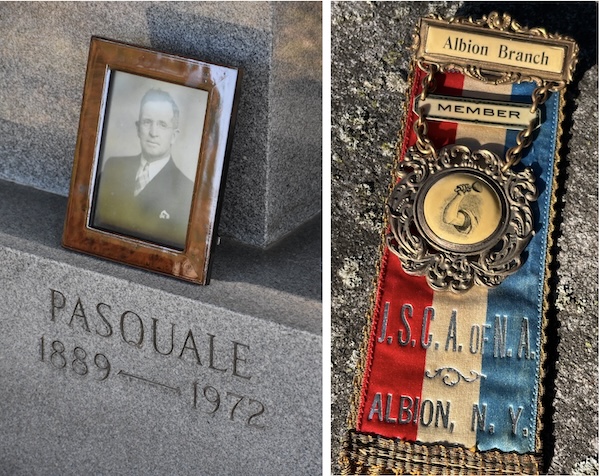75 attend final cemetery tour of summer, visiting the ‘new’ St. Joseph’s in Albion
Group gets rare look inside chapel with striking stained-glass windows
Photos by Tom Rivers
ALBION – A group of about 75 people walk by a statue of Joseph on Sunday evening during a tour of St. Joseph’s Cemetery on East Avenue.
This was the fifth and final cemetery tour of August. The Orleans County Historical Association organized the tours that also included Mount Albion, Robinson Cemetery in Clarendon, Millville Cemetery in Shelby and Greenwood Cemetery in Kendall.
Catherine Cooper, Orleans County historian, led the tour with Susan Starkweather Miller, the Village of Albion historian. Cooper is shown by the monument for the Cunneen family, including John Cunneen.
Cunneen, an Irish immigrant, came to the Albion community at age 12 in 1860, traveling by himself from Ireland. He made it to Albion by packet boat along the Erie Canal, joining cousins in Gaines. Cunneen would became a lawyer and served as attorney general for the state in 1903 and 1904. There is a historic marker about Cunneen at his former home on Platt Street, across from the County Jail.
Cunneen died in 1907 at age 58 of pneumonia. He was a lawyer in Buffalo at the time. The Bishop of Buffalo accompanied the body on a funeral train to Albion.
He was buried in the older St. Joseph’s Cemetery on Brown Road. When the new cemetery opened in 1920, Cunneen’s family agreed to have his grave moved to the new cemetery. The parish priest at the time encouraged people to move their relatives from old St. Joseph’s and offered them favorable terms. He secured a coup when the Cunneen family agreed to have John Cunneen’s body reinterred in a prominent place at the new cemetery.
Cunneen’s wife Elizabeth was buried at Mount Albion in 1917. Being a Presbyterian, she wasn’t allowed to be buried at the Catholic cemetery.
The tour on Sunday gave the public a rare opportunity to go inside the chapel at the cemetery. It has four stained-glass windows made by Frohe Stained Glass of Buffalo. Bill Lattin, retired cunty historian, wrote a book about the local stained-glass windows, Luminaries in the Firmanent.
“Truly these are amazing windows,” Lattin said.
They depict the birth of Jesus, the crucifixion, the resurrection and the ascension.
The chapel is 38 feet by 24 feet and is made of local Medina Sandstone. The building was big enough to fit about 50 people comfortably.
This photo shows the chapel in back and a 16-foot-high cross in front that depicts the crucifixion of Jesus. Below Jesus are Mary Magdalene, Saint John the Baptist and Mary, the Blessed Mother.
Sue Starkweather Miller speaks about Joseph A. Dibley Sr., a blacksmith who also created the world’s largest rolling pin in 1929 when a 3-ton apple pie was made, setting a new record at the time. Charles Howard, founder of a Santa School, led the pie-making effort.
The rolling pin is 4 feet long and weighs 60 pounds. Dibley’s great-granddaughter Loraine Dibley brought the rolling pin to the tour on Sunday.
Dibley’s blacksmith shop was on West Bank Street, the site of the current Gotta Dance studio.
Catherine Cooper talks about the Rt. Rev. Msgr. Francis Sullivan, who served as parish priest in Albion for just over 50 years. A native of Hartland in Niagara County, Msgr. Francis Sullivan was pastor of St. Joseph’s Church from May 19, 1897 to Dec. 13, 1946. During his time in Albion, he celebrated more than 26,000 Masses, performed 660 marriages and 2,017 baptisms.
The first Catholic cemetery in Albion was on Brown Road in Gaines. The 3-acre site was purchased by Father Castaldi in 1873 and named Holy Cross Cemetery but was referred to as St. Joseph’s Cemetery, now St. Joseph’s old cemetery.
Msgr. Sullivan felt the old cemetery was too far outside the village. He saw prominent people selecting Mt. Albion for their final resting place and he felt deceased Catholics should also be entitled to a prominent final resting place, Cooper said.
When Msgr. Sullivan arrived in Albion in 1897, he saw a completed new church structure on West Park Street, but a parish that was deeply in debt. Sullivan led the parish in clearing the debt, and then in building the lyceum, convent, rectory and a sexton’s house. In 1920, he purchased the 14 acres for the new cemetery and chapel.
He also served on the Albion Board of Education for 18 years and was on the building committee for construction of grammar school on Academy Street.
During his time in Albion, he celebrated more than 26,000 Masses, performed 660 marriages and 2,017 baptisms. He was able to persuade the local quarrymen to nearly give the sandstone for the new chapel.
David Snell shares about his father, Peter Snell, who was abandoned and left as an orphan in Buffalo. Young Peter was known as “Billy Knight” before he was adopted by an Albion family at age 4. The display shows Peter’s baptismal clothes when he was adopted by his family.
Peter would go on to serve in World War II. He survived abandonment and the Great Depression before starting a real estate business in 1957 that David continues to operate on Main Street in Albion. Peter passed away in 2000.
The tour highlighted Pasquale DiLaura, who was a key owner and proponent of Medina Sandstone after most of the quarries had closed by 1920. DiLaura kept the Medina Sandstone industry alive in Orleans County from the 1920s through the 1960s.
He was a member of the Albion branch of the Journeymen Stone Cutters Association of North America. His ribbon from the union was passed around on Sunday’s tour.
DiLaura bought the O’Brien Quarry on Howard Road in Clarendon. He kept his employees paid during the Great Depression even when there was little work to be done.
The DiLaura Stone Co. did the Medina Sandstone work on the bridges and culverts on the Lake Ontario State Parkway in the 1950s and 1960s, perhaps the last major public works project with local Medina Sandstone.
In the 1920s and ’30s, DiLaura was urged to leave the Albion area and join many of his quarrymen friends who left the area to the work in the auto factories in Detroit and Michigan.
DiLaura decided to stay put. He bought the quarry in Clarendon. DiLaura kept promoting the product and gave it about 40 more years of life.
He wrote letters to U.S. senators and the Works Progress Administration in Washington, D.C., urging them to pick a project with Medina Sandstone for the public benefit. DiLaura led the crews that built the Hamlin Beach State Park. He taught the young men in the Civilian Conservation Corps how to cut stone. Many of those structures endure about 80 years after they were built.
DiLaura was among a large group of quarrymen who came to Orleans County from Alfedena, Italy. DiLaura’s forefathers were stone cutters for 950 years, working on projects in Italy, Starkweather said.
DiLaura also was the first Italian elected to the Albion Board of Education. He served in that role for 30 years.
“He was truly a champion of this area and this community,” Starkweather said.
















